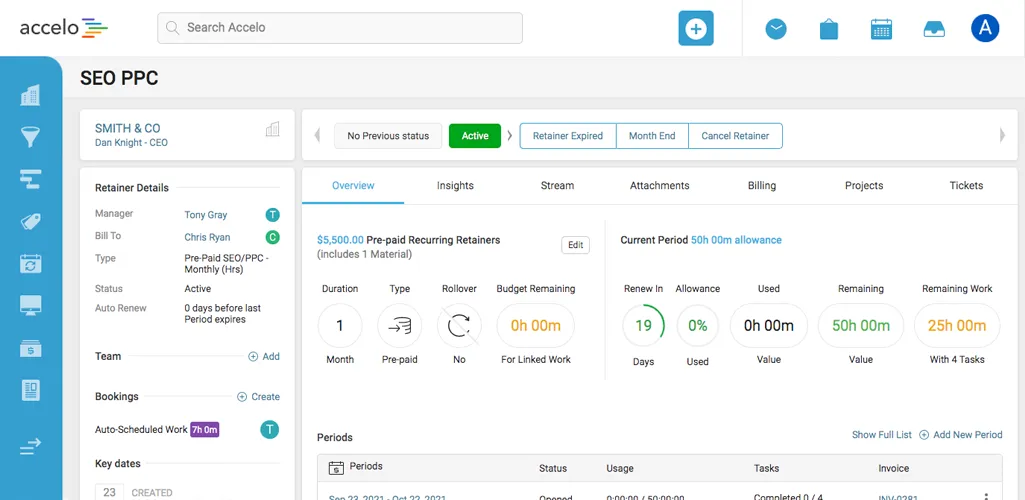Accelo Acquires Forecast, Adding Depth to AI and Capacity Planning Capabilities
Read the Press Release



Providing services your clients are happy with should make you happy. Ironically, it can bring up some mixed feelings when you’ve done a great job and the project is over — because that may mean the end of your contract.
If you dread having to pursue new business and love established relationships with good clients, retainers are a great option. Recurring work provides peace of mind and steady revenue. Being able to turn to a trusted business for the same or similar services benefits clients, too.
However, internally managing these ongoing relationships might prove harder than you initially thought. Retainers are more complex than a set of monthly recurring tasks. To be successful with a significant number of clients on retainer, you should carefully think through the contract management and service delivery components of this type of agreement.
Retainers are a unique type of contract, one in which clients place faith in your business by paying before they receive services. They’ll expect you to return that good faith and deliver on your promises.
<10-profitability-essentials>
While there are different types of retainers, you should have a consistent set of terms and conditions you stick to. They should cover what you will provide, when or for how long, what you expect from the client and what they can expect from you. Embed these in a template so you don’t forget to include them in each new agreement.
This isn’t just best practice to protect your business, but a way of establishing the parameters for the kind of connection you want to have. Remember, these clients have proactively decided to come back to you for services on a regular basis. Let your gratitude for their loyalty seep into the language you use in this first communication.
Getting a retainer in place should set in motion a sequence of internal actions and decisions to support being a partner to your clients.
As the above steps demonstrate, true retainer management involves a lot more than repeating a few tasks. Successfully holding on to your best clients means completing their work thoughtfully, delivering it on time and billing them accurately.
Technology should help you achieve all of these aims. Unfortunately, getting support specifically for retainers is difficult, as there’s a fallacy in the client work management space that recurring contracts can be maintained solely by creating recurring tasks.
Focusing on tasks alone doesn’t work because it disregards:
Recurring tasks may serve as reminders to complete ongoing work, but the entire retainer management process is still largely manual. If you’re expending additional resources internally to keep up with retainers, you’re negating some of their benefits. As you gain more and more recurring clients, the monthly burden could become quite costly.
Keep in mind: Retainers aren’t right for every client. To be successful with a retainer model, you should consider whether it’s a good fit for both your services and the client’s needs. How often will you be demonstrating value to your retainer clients? Some people will find it problematic to pay every month and not hear from your team very often. Clients who seem hesitant or anxious about getting their money’s worth may be better off with a traditional hourly billing structure.
When you’re ready to fully support the clients who value your services the most, you need a platform that’s capable of doing so with as little manual input as possible.
Accelo has a true Retainers product that empowers you to:

Imagine how many more clients you could transition to recurring contracts if your business had these capabilities.
READ NEXT: MarTech consultancy Tegrita increased client commitments by 90%
Reduce the burden of attracting new leads and selling your services to those who are unfamiliar with your work. Focus on adding value for the clients you already have, and let Accelo manage your retainers in the background! Learn more about how automated retainer management works in our platform by starting your free trial or scheduling a demo.

